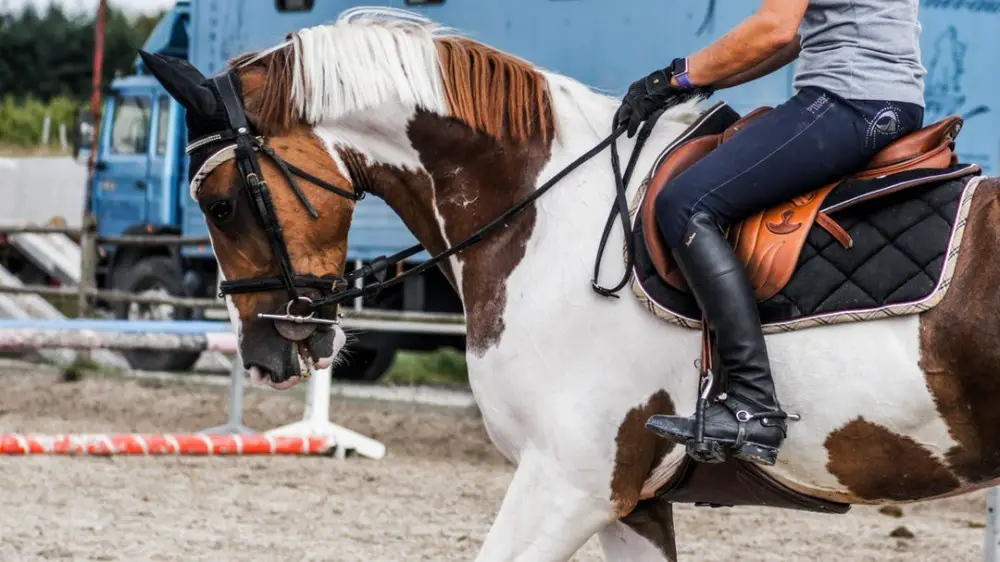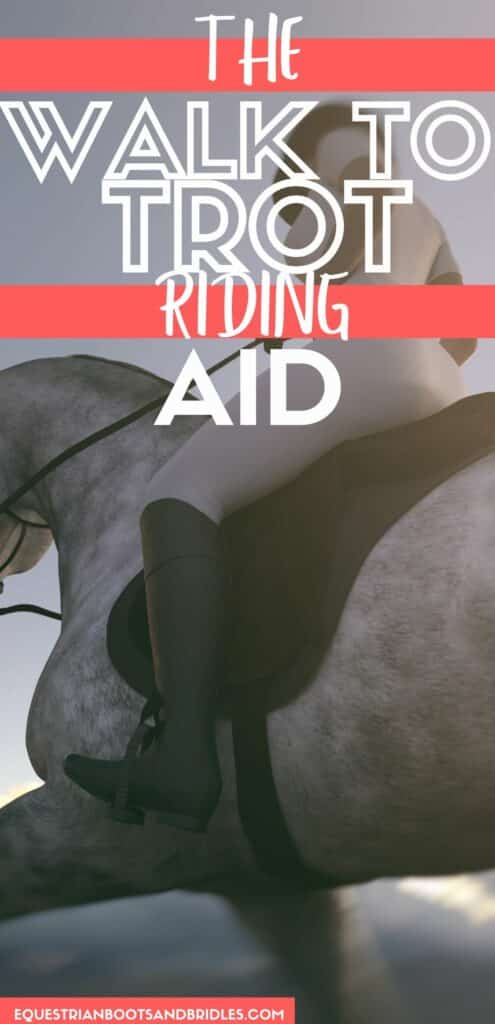I want to address a simple yet important skill that can help you hone in on how well you’re communicating with your horse. I call this my “secret” walk-to-trot riding aid although it’s really not that secret! You probably already know it but the trick is staying mindful of it and really implementing it when you’re riding.
I talk all about my secret walk-to-trot riding aid as well as all the other stuff I WISH I knew when I was learning how to ride in my 100% FREE Beginner Rider’s EBook: Click here to learn more!
If you’ve read my post on speeding up a slow horse, then you’ve already covered this to some extent but I want to make this post specific to the trot.
I’m going to share this with you and it will help you get up into a trot without all the hassles when you’re riding a slower horse that’s maybe a little tricky to motivate.
You might have already read about my first pony, Satchmo. If you haven’t, he was the CUTEST little guy. He was super feisty and had a world of personality. He would also routinely kick other horses if they got too close. All this personality but he hated leading. Absolutely hated it.
When I was riding him, I spent a lot of time working on my walk-to-trot transition and also on different types of trotting as I was learning how to ride. I rode English with him and we would work on lengthening and shortening the stride, keeping the trot even, sitting trot, posting trot, two-point at the trot, lateral work in the trot, etc.
The point is, there was a LOT of trot work.
And rightfully so, because a lot of work on horses is done at the trot. That’s why it’s super important to master that walk-to-trot transition. We don’t want the horse to be pulling itself up my it’s front legs and kind of having the “finnnnnne, I guess I’ll trot” mentality. We want it to be enthusiastic and responsive but controlled.
One problem I had a lot is that Satchmo would either lurch forward in the trot when I was following other horses with him or he would refuse to trot when I was trying to lead with him. When I finally did get him to trot for that first little bit when we were riding together, I never felt quite balanced. I didn’t know it at the time, of course. I was just learning to ride and I was thrilled to just be trotting!
Once I understood how to better communicate with Satchmo, we felt extremely in sync when we were trotting, walk-to-trot transitioning and trot-to-walk transitioning.
Let’s see if you’ve experienced this problem…
Are You Having Difficulty with the Walk-to-Trot Transition?
When transitioning from the walk to the trot, it’s natural to resort to the usual squeeze, kick, crop routine.
Usually that first walk to trot transition at the very beginning of a lesson or a ride is the hardest one. At least that’s what I always found!
Not only is it exhausting kicking and squeezing to get that first trot but it also doesn’t feel good. Don’t you wish your horse could just read your mind and pick up a lovely trot the second you ask?
I remember seeing horses easily trot off and it didn’t even seem like the rider did anything. I felt so envious!

The Hack: Using Your Seat is Better Than Using Your Leg
What I learned as I developed my horse riding skillset is that your seat is a really vital communication tool. I remember coaches telling me that all the time but I never really internalized it until later in my riding. It felt so much more natural to use my legs and also I didn’t fully understand what using my seat meant. I tried to move with my horse as best I could but mostly it felt off.
The trick to using your seat is to set the pace that you want to go RATHER than trying to mimic your horse’s pace.
I repeat, you set the pace with your seat! Don’t just try to follow your horse’s movements.
Using your seat communicates to your horse more clearly and it makes you look like a far more sophisticated rider than squeezing and kicking a walking horse.
So here’s what to do: While walking, start to move your seat deliberately as if your horse was starting to trot. Speed it up and almost picture using your bum and hips to urge your horse forwards.
Another way to think of it is to imagine that you’re riding the sitting trot and essentially start to mimic that motion on a horse that’s walking.
Once the horse moves faster, then your seat suddenly becomes in sync with the horse’s movement and the horse feels a release of pressure because he doesn’t feel you moving all over the place on top of him.
Yes I know it probably feels super silly! After over-exaggerating it a few times, your horse will start understanding what you mean much faster and you’ll be able to just use the most subtle movement of your seat to move your horse into the trot.
Use The Walk-to-Trot Riding Aid First
Try to use this walk-to-trot riding aid first before you use your legs. Be patient and persistent. And don’t worry about being too demanding – I used to, but I’ve realized my horse doesn’t mind me using this trick at all!
I really hope this walk-to-trot riding aid makes a difference to your riding. I would love to hear how it goes for you! And for more trotting help, have a look at my guide on how to sit the trot once you’re there!
The Same Principle Applies to the Trot-To-Walk Transition
The same principle of slowing down your seat in order to communicate with your horse that you want to slow down is used for the trot-to-walk transition with your horse.
Initially, you might have to exaggerate a little bit.
If your horse is on the hotter side, you probably found the walk-to-trot transition a breeze and you might find this one a little bit more difficult. If your horse is on the lazier side, than this should be absolutely no problem for you.
If your horse is on the hotter side, make sure you read my blog on how to slow down a hot horse (click here!) as there might be a lot more you need to do before your able to just use your seat. It depends on the level of emotional control your horse has and you might have to work on that a little bit first before your horse is able to actually listen to your seat.
If you enjoyed this post, you might enjoy my FREE Beginner Rider’s EBook! You’ll learn how to keep a consistent pace (whether you’re riding a fast or slow horse), how to make smoothen transitions, how to finally get the flexion and bend you want, The Emergency Brake as well as bonus chapters on making cantering and jumping so much easier!
I hope you enjoyed the post! Pin it!


